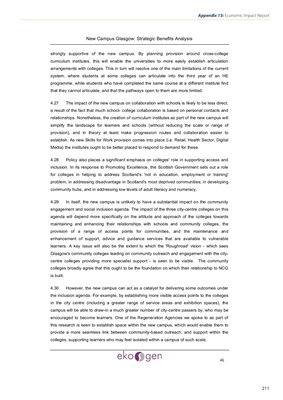
New Campus Glasgow: Strategic Benefits Analysis
46
strongly supportive of the new campus. By planning provision around cross-college
curriculum institutes, this will enable the universities to more easily establish articulation
arrangements with colleges. This in turn will resolve one of the main limitations of the current
system, where students at some colleges can articulate into the third year of an HE
programme, while students who have completed the same course at a different institute find
that they cannot articulate, and that the pathways open to them are more limited.
4.27 The impact of the new campus on collaboration with schools is likely to be less direct,
a result of the fact that much school- college collaboration is based on personal contacts and
relationships. Nonetheless, the creation of curriculum institutes as part of the new campus will
simplify the landscape for learners and schools (without reducing the scale or range of
provision), and in theory at least make progression routes and collaboration easier to
establish. As new Skills for Work provision comes into place (i.e. Retail, Health Sector, Digital
Media) the institutes ought to be better placed to respond to demand for these.
4.28 Policy also places a significant emphasis on colleges' role in supporting access and
inclusion. In its response to Promoting Excellence, the Scottish Government sets out a role
for colleges in helping to address Scotland's 'not in education, employment or training'
problem, in addressing disadvantage in Scotland's most deprived communities, in developing
community hubs, and in addressing low levels of adult literacy and numeracy.
4.29 In itself, the new campus is unlikely to have a substantial impact on the community
engagement and social inclusion agenda. The impact of the three city-centre colleges on this
agenda will depend more specifically on the attitude and approach of the colleges towards
maintaining and enhancing their relationships with schools and community colleges, the
provision of a range of access points for communities, and the maintenance and
enhancement of support, advice and guidance services that are available to vulnerable
learners. A key issue will also be the extent to which the 'Roughroad' vision - which sees
Glasgow's community colleges leading on community outreach and engagement with the citycentre
colleges providing more specialist support - is seen to be viable. The community
colleges broadly agree that this ought to be the foundation on which their relationship to NCG
is built.
4.30 However, the new campus can act as a catalyst for delivering some outcomes under
the inclusion agenda. For example, by establishing more visible access points to the colleges
in the city centre (including a greater range of service areas and exhibition spaces), the
campus will be able to draw-in a much greater number of city-centre passers by, who may be
encouraged to become learners. One of the Regeneration Agencies we spoke to as part of
this research is keen to establish space within the new campus, which would enable them to
provide a more seamless link between community-based outreach, and support within the
colleges, supporting learners who may feel isolated within a campus of such scale.
211
Appendix 13: Economic Impact Report